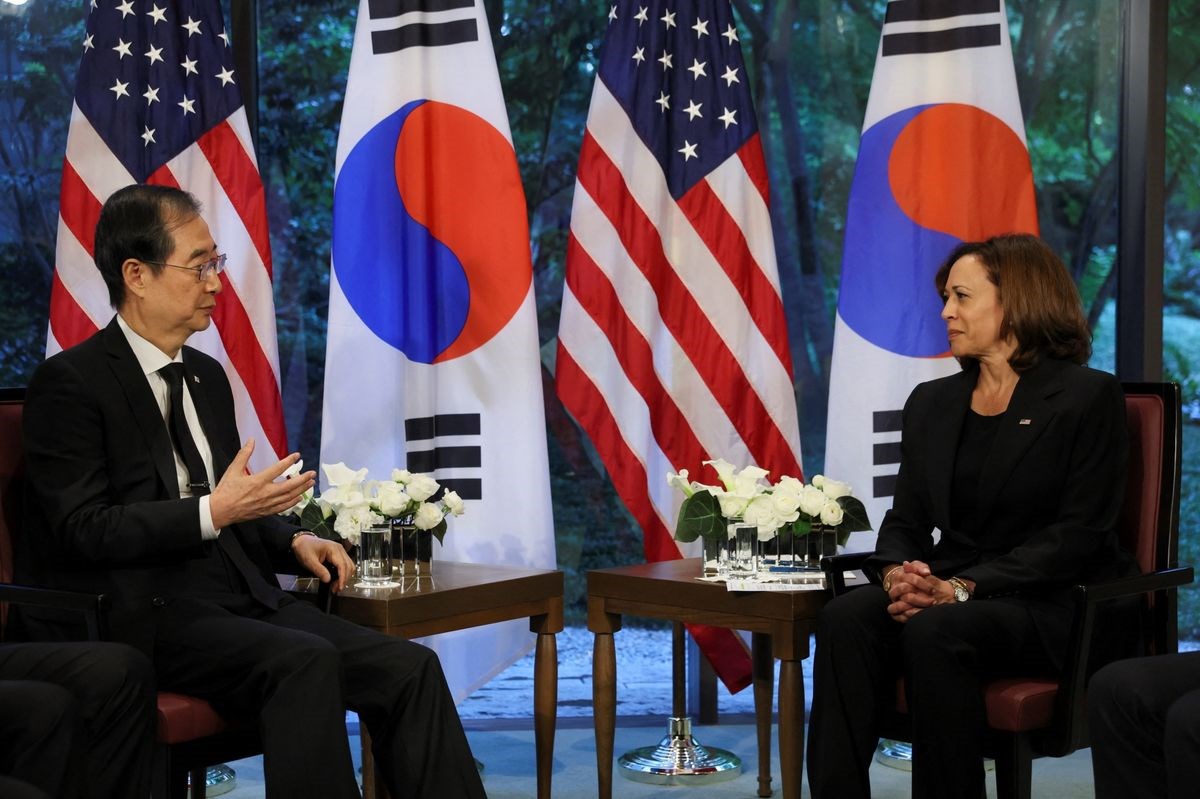Kamala Harris concludes Asia trip with visit to Korean DMZ
US VP Kamala Harris visits the demilitarized zone on Thursday despite continuous warnings from the Democratic People's Republic of Korea.
-

US VP Kamala Harris with South Korean President Han Duck-soo in Tokyo (AFP)
US Vice President Kamala Harris on Thursday visited the heavily fortified Demilitarized Zone (DMZ) dividing South Korea from the Democratic People's Republic of Korea (DPRK).
At the DMZ, Harris and South Korean President Yoon Suk-Yeol condemned the DPRK's missile launches and called them "provocations" at a time when the US has been strengthening and expanding its military and strategic presence in the Pacific.
Harris and Suk-Yeol argued that the DPRK is threatening the region's stability and continued to explain, in a clear show of double standards, how the joint US-South Korea drills and the upcoming joint tactical drills with Japan will solidify its presence in the pacific.
Despite warnings from Pyongyang, the US still conducted maritime drills and Harris visited the DMZ while also continuing to demonize the DPRK and its leader Kim Jong Un.
It is worth noting that two months ago, the DPRK condemned US House Speaker Nancy Pelosi's visit to the heavily fortified DMZ, branding her the "worst destroyer of international peace."
Pelosi, who traveled to Taiwan in the first week of August, became the highest-ranking US official to visit the Joint Security Area (JSA) between the two Koreas since then-President Donald Trump met DPRK leader Kim Jong-Un there in 2019.
A few days earlier, at the United Nations General Assembly, Pyongyang's ambassador to the UN, Song Kim, criticized the US and South Korea for their joint military drills, saying they were bringing the Peninsula to "the brink of war". The ambassador further added that Washington's "hostile policy" towards Pyongyang was the reason the world was now "heading into a much more dangerous phase."
US-Japan-South Korea joint tactical drills revealed
The Japan Maritime Self-Defense Force (JMSDF) revealed on Thursday that it will be holding joint tactical naval exercises alongside South Korea and the US later on Friday.
The purpose of the exercises taking place in the Sea of Japan is to allegedly strengthen cooperation between the navies of the three countries.
The official statement read that "The JMSDF will conduct a trilateral exercise with the US Navy (USN) and the Republic of Korean Navy (ROKN) in order to strengthen cooperation and to realize a ‘Free and Open Indo-Pacific," adding that the drills also target developing countermeasures against submarines.
The statement revealed that the vessels that will be involved in the training are the Japanese Asahi-class destroyer, the US aircraft carrier USS Ronald Reagan, the US destroyers USS Barry and Benfold, the US missile cruiser Chancellorsville, and a US nuclear-powered general-purpose attack submarine, as well as the South Korean Mun Mu Daewang combat ship.
US and South Korea conduct maritime drills
The nuclear-powered USS Ronald Reagan, the USS Chancellorsville, a guided-missile cruiser, and the USS Barry, a guided missile destroyer, which anchored in Busan, South Korea on September 23, were taking part in military drills with the South Korean maritime forces on Monday.
The drills come after a day after the DPRK allegedly launched a short-range ballistic missile into the Sea of Japan, according to South Korean news agency Yonhap, citing the Joint Chiefs of Staff (JCS).
The drills will take place over the course of four days and are aimed to demonstrate the allies' “powerful resolve to respond to North Korean [DPRK] provocations” and advance their ability to conduct joint naval operations, according to a statement from the South Korean navy.
In addition to the US naval vessels aforementioned, the South Korean navy stated that more than 20 US and South Korean navy ships were mobilized for the drills, alongside US and South Korean fighter jets and helicopters that will also take part in the training.
USS Zumwalt sails in the Western Pacific
Earlier Tuesday, former US Navy captain and analyst Carl Schuster revealed that the US navy's most advanced surface warship, the USS Zumwalt, is conducting a mission in the western Pacific that might pave the way for the future stationing of US hypersonic missiles in the area.
According to Schuster, “The presence of a stealth warship will draw a great deal of [Chinese] interest,” particularly if the Zumwalt is armed with hypersonic missiles.
The USS Zumwalt is one of three multi-mission guided missile destroyers in a class that the Navy claims would “create a new level of battlespace complexity for potential adversaries.”
South Koreans protest against US-Seoul war drills, demanding US out
The magnitude of the US administration's influence over mainstream media is no hoax, notably as there were barely any reports about the thousands of South Korean unionists and supporters who rallied in Seoul's downtown on August 13 to protest against the joint US-South Korea war games.
There's a Western media blackout of protests in South Korea against US military exercises.
The drills, which were the largest in years, come after the election of incumbent President Yoon Suk-yeol, who promised tougher stances against North Korea. Union leaders, however, have been concerned regarding the risks that come with such policy.
South Koreans held banners demanding that the US leave their land.
Many South Koreans argue that the US military and Seoul's alliance with Washington prevent the improvement of ties with DPRK, generating further tension.
Read more: US Cutter encounters Chinese, Russian Navy vessels

 5 Min Read
5 Min Read










